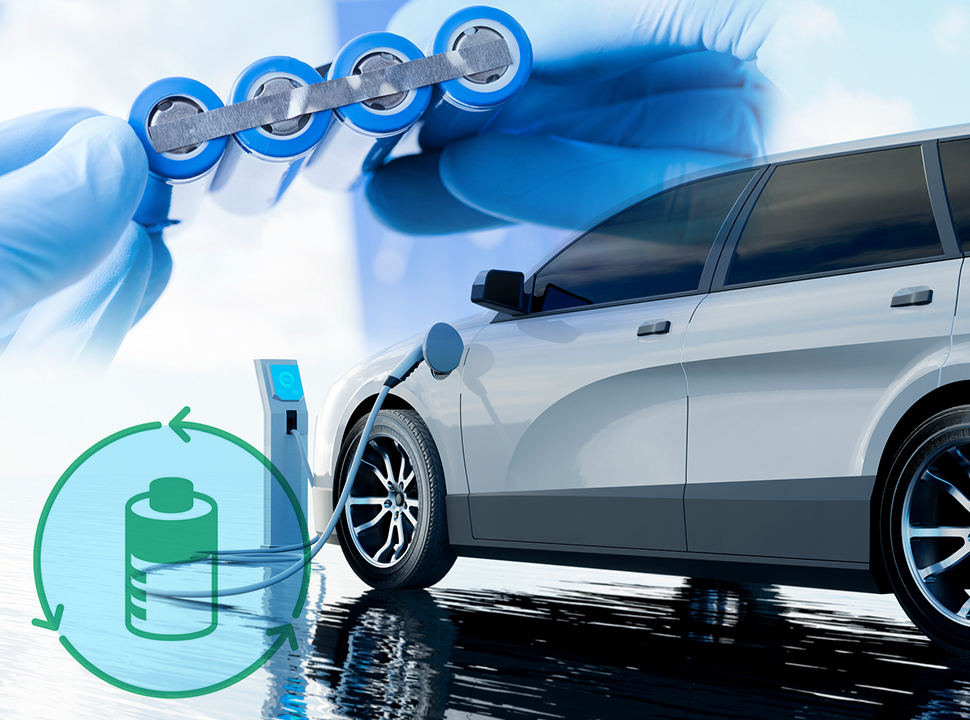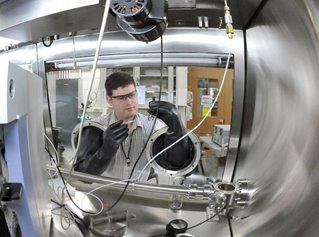Innovation Needed to Reclaim Lithium from Old Batteries
Innovation Needed to Reclaim Lithium from Old Batteries


American regulators are looking to implement recycling standards for lithium-ion batteries to reduce waste, poor labor conditions, and pollution.
Lithium batteries are everywhere: They’re used in everything from headphones and small appliances to electric vehicles and energy storage facilities. As sales of lithium-ion (Li-ion) batteries surge, the industry must turn its focus to recycling, said Jeff Spangenberger, materials and recycling research group leader at Argonne National Laboratories.
Without a large recycling effort in place, the United States could be stuck with a glut of Li-ion batteries that pollute the environment as they break down.
Time is of the essence for these efforts, as some of the earliest-produced electric vehicles are expected to hit scrapyards in significant numbers next year. Later model electric vehicles won’t be far behind, Spangenberger said.
“If we don’t innovate to address end-of-life challenges and consider environmental impacts as more and more batteries are being produced, then we’re going to have a big problem ten years from now,” he said.
Recycling Li-ion is a more problematic undertaking than other recycling processes, said Gavin Harper, a research fellow at the government-backed Faraday Institution in Didcot, England.
“We can't recycle complex products like batteries the way we recycle other metals. Shredding, mixing up the components of a battery and pyrometallurgy destroy value," he said.
More on Recycling: Rebuilding with Recycled Concrete
The industry for recycling and reuse of battery material is already underway. The metals recovered by Li-ion recyclers is becoming a growing source of material for battery makers, said Hans Eric Melin, managing director at Circular Energy Storage, a London agency that reports on Li-ion battery recycling and storage capacities.
But recycling the batteries has traditionally been a labor-intense, dirty process that involves burning them to recover metal or grinding them for what’s called “black mass.” What’s more, rather than focusing on recyclability, manufacturers have been preoccupied by zeroing in on ways to make their products cheaper and more efficient, he added.
Another big drawback to the fledgling recycling process is a lack of standardization. In the United States, that should be changing soon. Standards could help regulate the labor-intensive, pollution-filled process, Melin said.
To standardize Li-ion recycling methods, Argonne teamed with the National Electrical Manufacturers Association (NEMA). The group will write standards, which will differ according to battery design, said Jonathan Stewart, industry director of NEMA’s Utility Products and Systems division.
Editor's Choice: How Are Robots Helping Us to Recycle Better
“Standards can give recyclers a baseline for how much material, and in turn how much revenue, they can expect to recover from a battery,” Stewart said. “They can also help manufacturers understand what materials and designs are likely to be more recyclable, which can inform their research and development.”
Standards for a complicated and varied recycling process can be hard to formulate. Variations in battery designs, materials, and chemistries, as well as recycling methods, can all affect recyclability. This makes the process of developing a common set of standards extremely complex, Spangenberger said.
“But the complexity can no longer stand in the way,” he said.
To begin the standards-setting process, Argonne and NEMA experts will look at how variations in battery design, materials, chemistries, and recycling methods come together to affect recyclability. During the process, the experts will meet with other, pertinent organizations, including the U.S. Department of Energy’s renewable energy vehicle technology group.
Argonne has put its focus on Li-ion batteries in recent years. In 2019, it introduced its ReCell model, which compares the cost and environmental impact of a battery with virgin material to the same battery with recycled content. The model calculates the impacts at each stage of its life cycle, allowing each to be individually changed and assessed. The model can be used as a tool to help find ways to attain the lowest costs with the least environmental impact.
The Recell model will help Argonne scientists and NEMA experts assess the amount of extractable and recyclable material in various battery systems.
Verifying how much material from the batteries was recycled in 2020, or any of the past years, is difficult because the recycling and reuse industries can be secretive, according to a Circular Energy Storage report.
Also, most companies in the industry are small or mid-sized with no obligation to disclose information. But the growth of electric vehicles (EV) surely impacted material recovery and, in fact, is bringing a boom to the Li-ion recycling industry.
Selected for You: Unlocking Composite Carbon Fibers for Recycling
Global sales of the vehicles increased by 160 percent in the first half of 2021, according to Circular Energy Storage. The consultancy said that EVs will represent 77 percent of the total installed Li-ion battery capacity by 2030, a huge increase from today’s 51 percent.
With the advent of standardization, a greater percentage of the materials that make up those batteries can be re-used and recycled, Spangenberger said.
And that is an important step toward keeping Li-ion batteries from polluting the world that EVs are trying to save us from.
Jean Thilmany is a freelance writer in Saint Paul, Minn.
Without a large recycling effort in place, the United States could be stuck with a glut of Li-ion batteries that pollute the environment as they break down.
Time is of the essence for these efforts, as some of the earliest-produced electric vehicles are expected to hit scrapyards in significant numbers next year. Later model electric vehicles won’t be far behind, Spangenberger said.
“If we don’t innovate to address end-of-life challenges and consider environmental impacts as more and more batteries are being produced, then we’re going to have a big problem ten years from now,” he said.
A Difficult Process
Recycling Li-ion is a more problematic undertaking than other recycling processes, said Gavin Harper, a research fellow at the government-backed Faraday Institution in Didcot, England.
“We can't recycle complex products like batteries the way we recycle other metals. Shredding, mixing up the components of a battery and pyrometallurgy destroy value," he said.
More on Recycling: Rebuilding with Recycled Concrete
The industry for recycling and reuse of battery material is already underway. The metals recovered by Li-ion recyclers is becoming a growing source of material for battery makers, said Hans Eric Melin, managing director at Circular Energy Storage, a London agency that reports on Li-ion battery recycling and storage capacities.
But recycling the batteries has traditionally been a labor-intense, dirty process that involves burning them to recover metal or grinding them for what’s called “black mass.” What’s more, rather than focusing on recyclability, manufacturers have been preoccupied by zeroing in on ways to make their products cheaper and more efficient, he added.
How Batteries Can Be Better Recycled
Another big drawback to the fledgling recycling process is a lack of standardization. In the United States, that should be changing soon. Standards could help regulate the labor-intensive, pollution-filled process, Melin said.
To standardize Li-ion recycling methods, Argonne teamed with the National Electrical Manufacturers Association (NEMA). The group will write standards, which will differ according to battery design, said Jonathan Stewart, industry director of NEMA’s Utility Products and Systems division.
Editor's Choice: How Are Robots Helping Us to Recycle Better
“Standards can give recyclers a baseline for how much material, and in turn how much revenue, they can expect to recover from a battery,” Stewart said. “They can also help manufacturers understand what materials and designs are likely to be more recyclable, which can inform their research and development.”
Standards for a complicated and varied recycling process can be hard to formulate. Variations in battery designs, materials, and chemistries, as well as recycling methods, can all affect recyclability. This makes the process of developing a common set of standards extremely complex, Spangenberger said.
“But the complexity can no longer stand in the way,” he said.
To begin the standards-setting process, Argonne and NEMA experts will look at how variations in battery design, materials, chemistries, and recycling methods come together to affect recyclability. During the process, the experts will meet with other, pertinent organizations, including the U.S. Department of Energy’s renewable energy vehicle technology group.
Argonne has put its focus on Li-ion batteries in recent years. In 2019, it introduced its ReCell model, which compares the cost and environmental impact of a battery with virgin material to the same battery with recycled content. The model calculates the impacts at each stage of its life cycle, allowing each to be individually changed and assessed. The model can be used as a tool to help find ways to attain the lowest costs with the least environmental impact.
The Recell model will help Argonne scientists and NEMA experts assess the amount of extractable and recyclable material in various battery systems.
Big Business, Little Reporting
Verifying how much material from the batteries was recycled in 2020, or any of the past years, is difficult because the recycling and reuse industries can be secretive, according to a Circular Energy Storage report.
Also, most companies in the industry are small or mid-sized with no obligation to disclose information. But the growth of electric vehicles (EV) surely impacted material recovery and, in fact, is bringing a boom to the Li-ion recycling industry.
Selected for You: Unlocking Composite Carbon Fibers for Recycling
Global sales of the vehicles increased by 160 percent in the first half of 2021, according to Circular Energy Storage. The consultancy said that EVs will represent 77 percent of the total installed Li-ion battery capacity by 2030, a huge increase from today’s 51 percent.
With the advent of standardization, a greater percentage of the materials that make up those batteries can be re-used and recycled, Spangenberger said.
And that is an important step toward keeping Li-ion batteries from polluting the world that EVs are trying to save us from.
Jean Thilmany is a freelance writer in Saint Paul, Minn.






